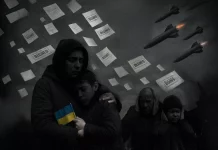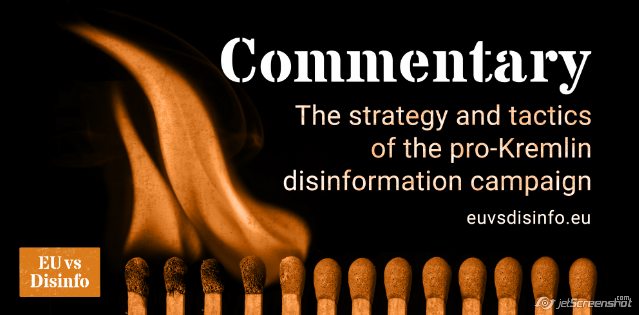
Introduction
East Stratcom was established in 2015 to “address Russia’s ongoing disinformation campaigns”, through (i) more effective communication and promotion of policies towards the Eastern Neighbourhood, (ii) a strengthened media environment in the region, and (iii) an improved capacity to forecast, address and respond to disinformation. Since then the EU itself has faced many of the same communications challenges as its Eastern Neighbourhood: Member States can also be surprised and caught off guard by the disinformation methods used, and increasingly contact East Stratcom for advice and best practice.
This article seeks to set out a detailed assessment of the nature of the challenge It is based on two and half years of daily observation of various parts of Russia’s disinformation and on the recommendations of a wide range of experts in this field.
The nature of the challenge
The pro-Kremlin disinformation campaign has one underlying strategy. Despite the diversity of messages, channels, tools, levels, ambitions and tactical aims, and notwithstanding its rapidly adapting nature, the strategic objective is one and the same – to weaken the West and strengthen the Kremlin in a classic zero-sum game approach. While it is important to be aware of this overarching strategic objective, we also need to understand how this objective is translated at the tactical level.
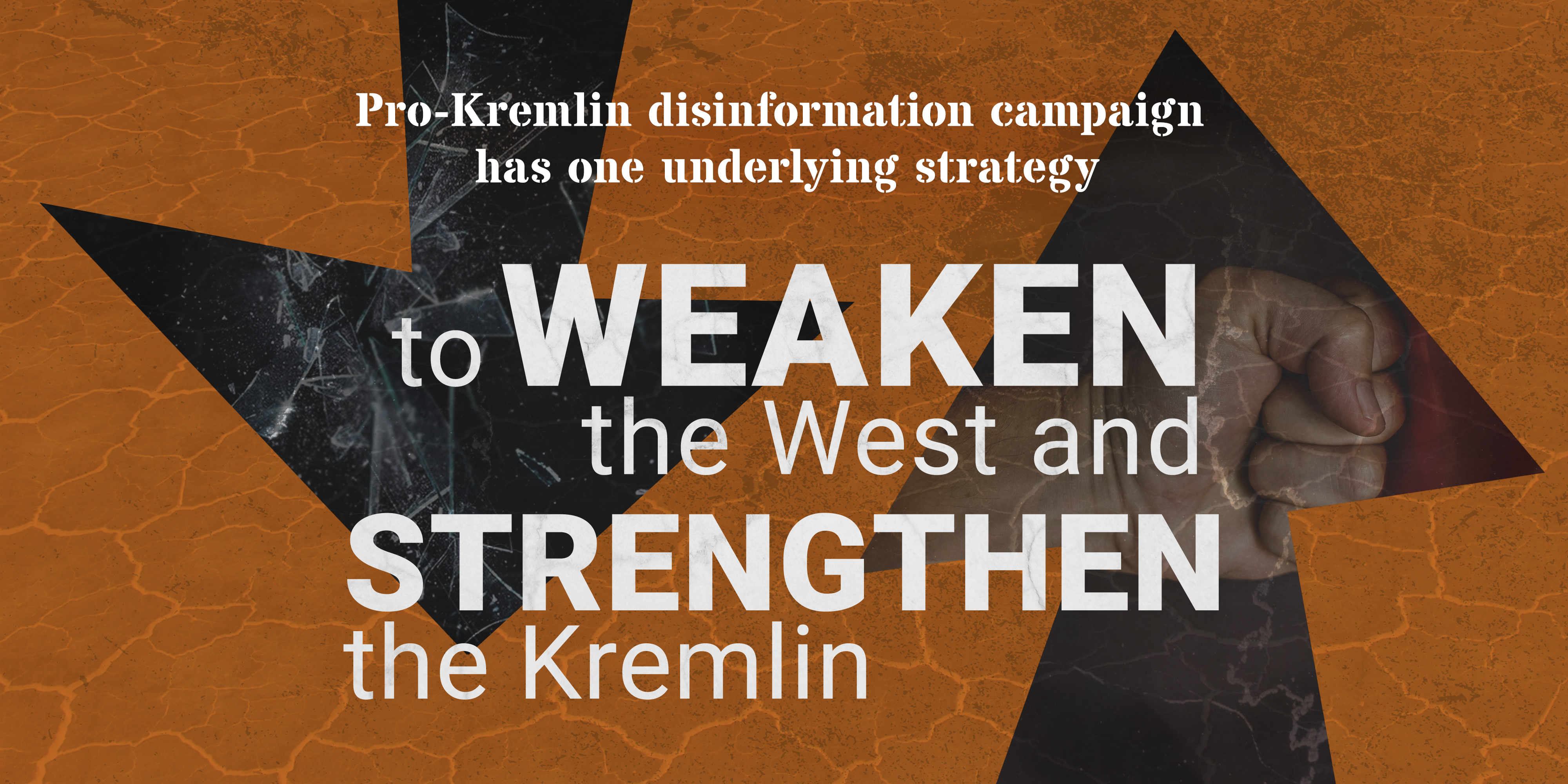
Disinformation has different messages for different audiences. There are different messages for Russians and for non-Russians; and for non-Russians in different parts of the world. The disinformation message that the EU turns people into homosexuals or paedophiles would be considered ridiculous in Western Europe, but can persuade some audiences in the Eastern Partnership countries. On the other hand, these audiences would probably find implausible the message that Ukraine is led by politicians with fascist beliefs – something which, on the contrary, could succeed with some audiences in some Western European countries. There will be different messages not only for different regions, but also for different socioeconomic groups, based on their age, education, income, status and occupation. The messaging that is used to influence a diplomat would not succeed with a student or a pensioner, and vice versa. And the disinformation that is used to have a short-term effect on people involved in our decision-making processes will be different from the messaging that tries to influence more general public opinion over the longer term.
The disinformation campaign uses different channels for different audiences. In Central and Eastern Europe, disinformation is mostly spread through dozens of dedicated outlets in local languages. But this tool proved to be ineffective in Nordic countries; where Sputnik had to shut down; the campaign there shifted towards social media, discussion forums in established outlets, cyber-attacks and online personal intimidation. Targeting the Russian-speaking minority might be the most effective tool in countries where there are many Russian speakers. Where social media is key for some audiences, especially in Western Europe, it is less relevant in Eastern Europe, where eg Twitter is not widespread. In Central Europe the older generation is often targeted by chain emails forwarded to thousands of addresses; but this technique is not really effective among the younger generation.
The disinformation campaign has an unknown number of channels and speakers, some of which are operating in a non-public environment, like closed events, direct messaging platforms and through people-to-people contacts. The scale encompasses the highest public authorities, diplomatic networks and security services; NGOs, GONGOs; official, “white” Russian media, unofficial, “grey” pro-Kremlin outlets and disinformation-oriented projects financed by pro-Kremlin oligarchs; local extremists and conspiracy theorists; social media trolls and bots; and individuals who simply get persuaded or attracted into the disinformation ecosystem. It adds up, every day, to a plethora of channels spreading a plethora of multilingual disinformation messages, and seeking to win new hearts and minds to continue the job. The sheer volume of disinformation and the constant repetition is key to the campaign’s success in creating a plethora of seemingly independent sources repeating the same message.
The campaign has different tactical aims and objectives for different audiences. It can present conspiracy theories to the audience that is ready to consume such conspiracies. It will play on pro-Russian and anti-Western feelings in one society, and exploit local national minority issues or anti-German/pan-Slavic emotions in another. It will fuel hysteria and polarisation through aggressively anti-refugee messaging or pro-refugee messaging (ditto anti-LGBT and pro-LGBT, or other divisive questions), to persuade both sides that those on the other side are an existential threat. It will try to find those issues in our societies that garner most emotions around them, and it will try to fuel and amplify these emotions as far as possible – because an audience shaken by strong emotions will behave more irrationally and will be easier to manipulate. Fear is by far the most abused emotion, as it is fear that manages to polarize societies the most. On an individual level, the actors of the disinformation campaign will try to intimidate individuals more prone to personal attacks. It also seeks to confuse mainstream media who try to balance between conflicting versions of events, turning this virtue of our media against us. It will overload those who try to find more sources of information, and denigrate those who call out these tricks.
The disinformation campaign has different perspectives. It can try to exploit existing divisions, or create new, artificial ones: on the more strategic level, like between the EU and NATO or the EU and the US; or at a national level, like between Western Europe and Eastern Europe, or two countries with historical issues. It will try to exploit, amplify or invent divisions within one society, between various socioeconomic groups, between various political parties, within one government or within one region. Again, any tool that weakens the West (be it on an international or an intra-national level) works.
Disinformation messages will often be built around an “element of truth” that will make them more believable and more difficult to call out. A typical current example is to take the real problems Europe faces with refugees, but then add false and/or twisted facts about their alleged crimes.
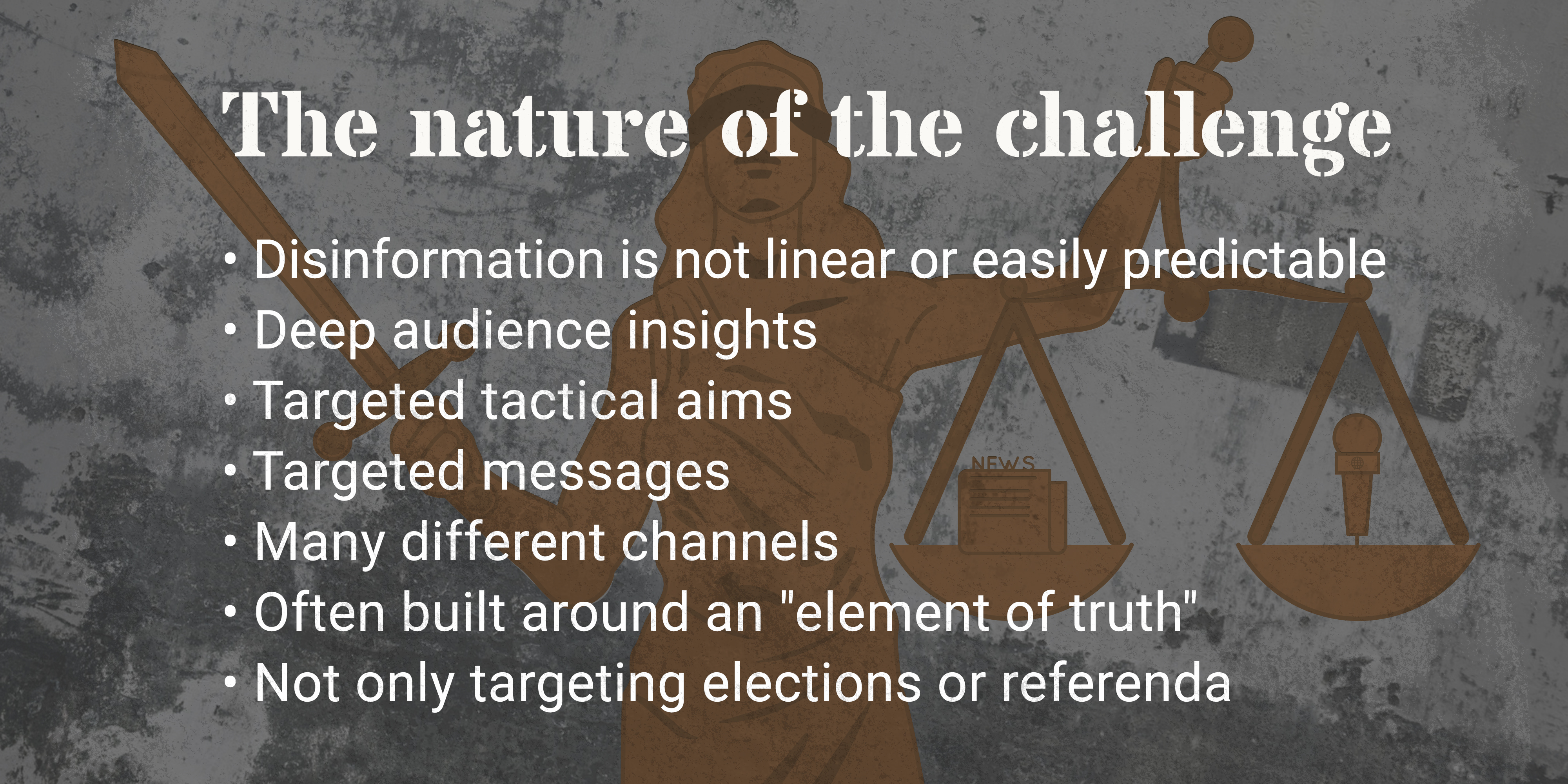
The disinformation campaign has different levels of ambition. The objective in 2014 was to help Russia achieve its military goals in Crimea. European elections and referenda were targeted in 2016 and 2017 in order to weaken consensus within Europe on the policy towards Russia. But it is not only about targeting elections or referenda. Operations with a lower level of ambition are also being conducted. These disinformation operations aim to undermine liberal democracy, and to sow and amplify mistrust in credible sources of information (be it governments or mainstream media), in the geopolitical direction of a country and in the work of intergovernmental organisations. They will also try to exploit and amplify divisions between different socioeconomic groups based on their nation, race, income, age, education and occupation. This type of disinformation campaign is often under the threshold of attention and is often overlooked as marginal. But it can achieve significant results over the long term. And these operations can facilitate more visible, short-term operations with a higher level of ambition that target particular electoral processes.
Given the amount of different messages, channels, tools, methods, targets and aims – and the significantly higher levels of experience in conducting a disinformation campaign and working with European audiences – it is safe to say that when it comes to audience reactions, the disinformers have a highly developed knowledge about our audiences. Most progress in the disinformation campaign seems to be based on trial and error, as evidenced by the example of Sputnik in Scandinavia and by shifts from one target group to another, eg in the political spectrum of a given country.
When it comes to our knowledge and that of the organisers of the disinformation campaign, the gap is wide and growing. The current disinformation campaign has been intensively exported out of Russia’s information space at least since the beginning of 2014, and many circumstances point to the fact that there was a long preparatory period before that. The organisers have managed to find out which messages and tools work for which particular audience, to plant the key narratives, to build familiarity with their messages (and this familiarity then leads to easier acceptance of the message), to identify local amplifiers and multipliers (both co-opted and inadvertent), and to plant and propagate some narratives so that their origin is already significantly obscured. Even an unsuccessful operation gives new knowledge, which is why even an operation that was on the face of it unsuccessful might still be valuable in the long term.
The disinformation campaign is not linear or easily predictable. Strategic narratives are implemented from the top, and some of the messages are top-down controlled (which is why there are regular weekly meetings of the Kremlin hierarchy with the most important Russian journalists from state-controlled media to issue instructions). But there are elements of a bottom-up approach too, with lower levels offering messages and communication projects to the top, anticipating what messaging and projects could find favour. To an untrained eye, this ecosystem might appear rather chaotic. But we should not expect easily measurable, causal relations where action A always necessarily results in situation B –academics studying the theory of media do not have them, and neither do advertising agents.
Thus, rather than an exact science where we can abstract variables and watch them interact in clean, isolated conditions, this can be described as a live ecosystem with an unknown amount of organisms and uncertain surrounding conditions, where no matter how much you know about this ecosystem, certain conditions and reactions will be unpredictable – where you can try to influence things, but cannot fully control them. This ecosystem is constantly evolving: fake quotes, letters and images will be soon joined by fake videos: a whole new level of sophistication making it increasingly hard, if not impossible, to identify real and mimicked human behaviour and posing new risks to mainstream media and public audiences.
It is not one message, media outlet, social media troll, conference or extremist that makes the difference. It is the sum that matters, the echoing that creates an environment of seemingly independent sources repeating the same message, which can lead an untrained observer to accept a story backed by so many “different” sources. It is the volume, the repetition leading to familiarity and the long-term effect of the disinformation campaign that form the core and basis of its success. Experienced experts compare this to a drop of water falling on a stone – it does not make the hole in the stone because of its force, but because of its persistence. Besides, the disinformation campaign is often accompanied by other, more “kinetic” measures with the same underlying strategy – cyber-attacks, hacking, disrupting communication channels or media outlets, plus economic, diplomatic, political and military measures. These additional measures can strengthen its effect significantly further.
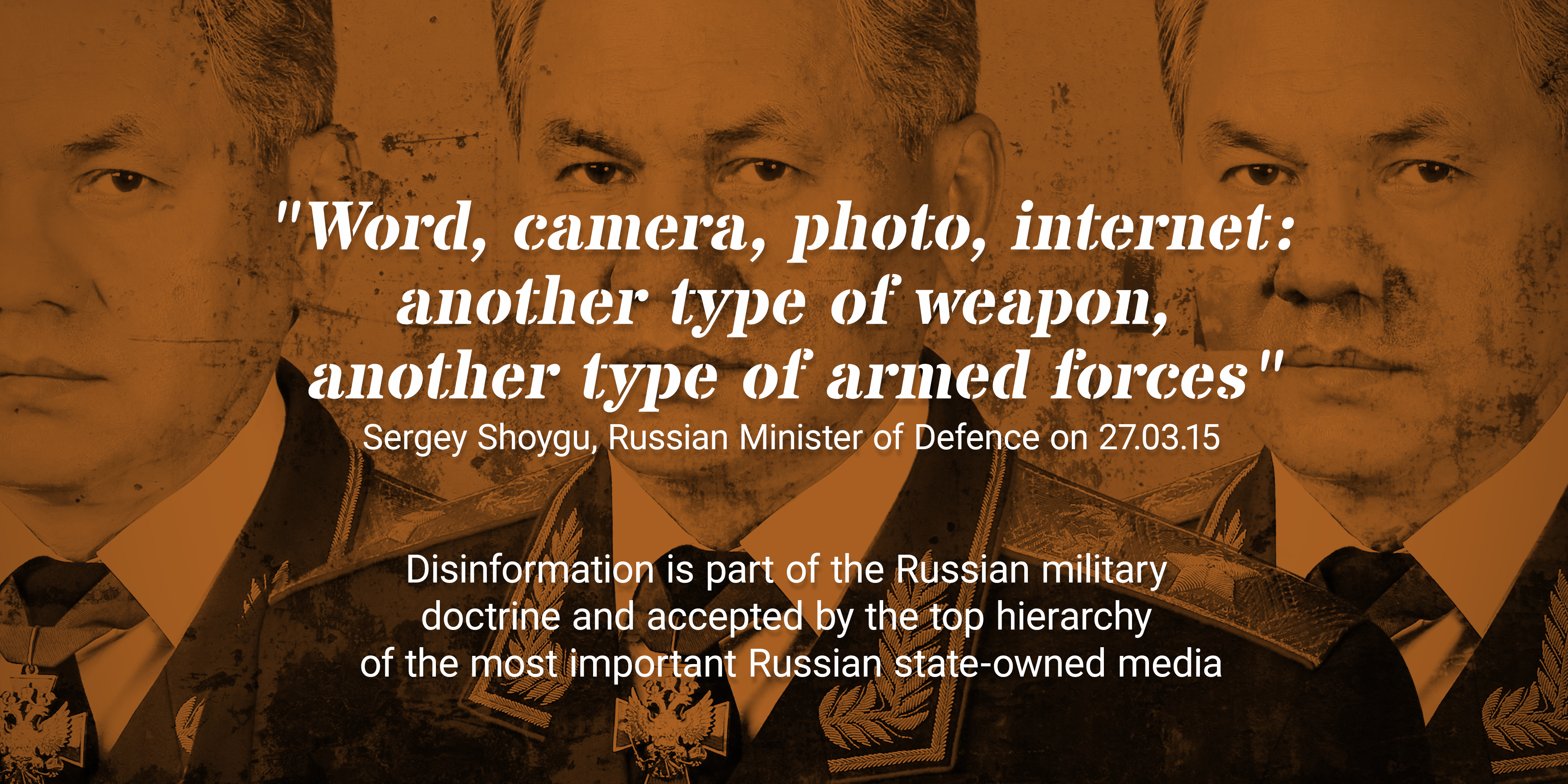
The disinformation campaign should be taken with the highest level of seriousness. It is part of Russian military doctrine and accepted by the top hierarchy of the most important Russian state-owned media. This is what differentiates it from other, less aggressive and not explicitly EU-targeted foreign influence operations. Journalists who actively participate in it receive presidential and military awards. The state demands, finances and rewards disinformation activity, as a cost-effective method of achieving its objectives. From public statements and budgetary planning decisions, it is clear that this is a strategy for the long term – meaning the gap in knowledge can grow ever wider. Among certain audiences, it has already achieved significant results that will not be quickly fixed, and it aims at broadening these affected audiences. The campaign is directly aimed at harming liberal democracy, rule of law and human rights, and at silencing those institutions, intergovernmental organisations, politicians and individuals who defend them.
In counter-acting the disinformation campaign, we need to prepare for the long run, and for a lot of repetition. Weeding out disinformation that was planted and cultivated for years will take time. There are people who accept facts at the moment they are shown them; but there are others who will need more time to correct their initially false belief. In any case, the defence of facts will require a lot of work.
Find a PDF-version of the text here.
This commentary was originally written for the Diplomaatia magazine: https://icds.ee/beware-of-russian-fake-news/


